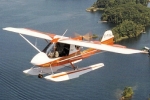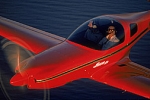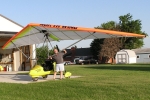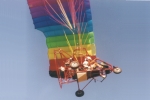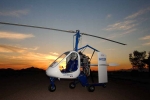|

G.
Michael Huffman
Sport Aviation Specialties, LLC
1512
Game Trail
Lawrenceville, GA 30044
770-548-1206

Copyright © 2005 - 2021
G. Michael Huffman
All rights
reserved
Disclaimer:
FAA regulations, orders, policies, ASTM publications, and other documents are
subject to change and interpretation. Any information on this site that pertains
to those documents is for reference only. It is the responsibility of visitors
to verify all such information with the FAA or ASTM. Site
optimized for 800 x 600 display |
- Do
you need more background on the subjects discussed on this site?
If
so, click the links below. Or, simply scroll down the page. If this information
does not answer your question, please feel free to contact us.
What
is a Light-Sport Aircraft (LSA)?
What is a Special
Light-Sport Aircraft (S-LSA)?
What is an Experimental
Light-Sport Aircraft (E-LSA)?
What is an Experimental
Amateur-Built (E-AB) Aircraft?
What
are the certification types for LSAs, S-LSAs, E-LSAs, and E-ABs? What
is a Light-Sport
Aircraft (LSA)?
(Back)
According
to the Federal Aviation Regulations Part 1, a light-sport aircraft is an aircraft
other than a helicopter or powered-lift that, since its original certification,
has continued to meet the following: - Maximum
takeoff weight
- Aircraft
not intended for operation on water- 1320 lbs
- Aircraft
intended for operation on water- 1430 lbs
- Lighter-than-air
aircraft- 660 lbs
- Maximum
speeds- 120 kts at maximum power
- Max
stall speed- 45 kts
- Maximum
seating capacity- 2 persons
- Single
reciprocating engine, if powered
- Fixed
or ground-adjustable prop
- Auto-feathering
prop OK for powered gliders
- Fixed-pitch,
semi-rigid, teetering, two-blade rotor system, if a gyroplane
- Non-pressurized
cabin
- Fixed
landing gear
- Retractable
landing gear OK for glider or seaplanes
Note
that this definition does not specify the certification category for the aircraft.
Any aircraft that meets these specifications is considered an LSA, regardless
of its certification type. Thus, according to the definition an Aeronca 7AC certificated
as a Standard Aircraft, a Challenger II certified as an Experimental Light-Sport
Aircraft, and a Sonex certificated as an Experimental Amateur-Built Aircraft are
all considered LSAs. This
distinction is important from the piloting side of the Sport Pilot/Light-Sport
Aircraft regulations, since the regulations allow a person to exercise sport pilot
privileges in any aircraft that meets the LSA specifications. That means a pilot
with a sport pilot rating or better in the appropriate aircraft category can legally
fly an LSA, no matter how it was certificated. What
is a Special Light-Sport Aircraft (S-LSA)?
(Back)
A special
light sport aircraft: - May
be in any of the following aircraft "classes"
- Airplane
(fixed-wing)
- Weight-shift
- Powered
parachute
- Glider
- Lighter-than-air
- (Note
that gyroplanes are not included in the allowable S-LSA classes.)
- Is
designed to meet LSA specifications
- Is
certified by the manufacturer to meet a set of industry-developed "consensus
standards" that specify design, testing, manufacturing, and quality control
requirements. Note that, unlike type certificated "standard" aircraft,
the FAA is not at all involved in the design, testing, manufacturing, and quality
control of S-LSAs.
- May
be sold complete, ready to fly
- May
be offered in kit form
- May
be built in other countries that have a Bilateral Airworthiness Agreement (BAA)
or Bilateral Aviation Safety Agreement (BASA) with the United States
- May
not
be modified unless approved by manufacturer
- May
have preventive maintenance done by sport pilot or better, if authorized by the
manufacturer's maintenance manual. Note that this is different from a type-certificated
aircraft, where preventive maintenance can be done by the owner.
- May
have maintenance and the annual condition inspection performed by either an A&P
mechanic or a Light-Sport Repairman- Maintenance (LSRM). A person can become eligible
for an LSRM certificate by attending an 80-120 hour training course.
- May
be flown at night or in IFR conditions only if allowed by the pilot operating
handbook and if properly equipped and maintained.
Examples
of S-LSAs include the Flight Design CT fixed-wing airplane, the Air Creation Tanarg
weight-shift aircraft, the Powrachute Airwolf 912 ULS powered parachute, and many
other fixed-wing, weight-shift, and powered parachute aircraft. What
is an Experimental
Light-Sport Aircraft (E-LSA)?
(Back)
An experimental
light sport aircraft: - May
be in any of the following aircraft "classes"
- Airplane
(fixed-wing)
- Weight-shift
- Powered
parachute
- Glider
- Gyroplane
- Lighter-than-air
- Is
one of three kinds:
- Previously
unregistered "ultralight-like" vehicle that meets LSA specifications.
These aircraft were required to be registered before January 31, 2008.
However, as that deadline
approached, the FAA issued exemptions which allowed the certification deadline
to be extended to January 31, 2010 for any ELSA that was registered before January
31, 2008. The January 31, 2010 deadline has now passed, so no other ELSAs will
be certificated under this provision.
- A
kit version of an S-LSA. Note that the January 31, 2008 deadline does not apply
here.
- An
S-LSA the owner elects to convert to E-LSA so he/she can make modifications &
perform maintenance. Note that the January 31, 2008 deadline does not apply here.
- May
be maintained or modified by anybody-there are no requirements on who may perform
maintenance or modifications on E-LSAs.
- May
have annual condition inspection performed by an A&P mechanic, a Light-Sport
Repairman- Maintenance (LSRM), or the owner as a Light-Sport Repairma- Inspection
(LSRI). An E-LSA owner can become eligible for an LSRI certificate by attending
an 16-hour training course. Note that an LSRI can perform the annual condition
inspection on only an E-LSA that he or she owns. Also note that an LSRI cannot
perform the annual condition inspection on an Experimental Amateur-Built aircraft
or a standard-categoy aircraft.
- May
be flown at night or in IFR conditions if appropriately equipped and maintained.
What
is an Experimental Amateur-Built (E-AB) Aircraft?
(Back)
An experimental
amateur-built aircraft: - May
be in any of the following aircraft "classes"
- Airplane
(fixed-wing)
- Weight-shift
- Powered
parachute
- Glider
- Gyroplane
- Lighter-than-air
- Is
not required to meet LSA specifications. Thus, E-ABs can have more than two passengers,
takeoff weights above 1320 lbs, retractable landing gear, variable-pitch propellers,
more than one engine, turbine engines, cabin pressurization, etc.
- The
"major portion" must
have been built by a person or group of persons solely for education and recreation.
- May
be maintained or modified by anybody-there are no requirements on who may perform
maintenance or modifications on E-ABs.
- May
have annual condition inspection by A&P mechanic or the original builder as
an Repairman- Amateur-Built. An E-AB builder who built the major part of his or
her aircraft can become an amateur-built repairman rating by simply applying for
the rating-no additional training is required. Note that the amateur-built repairman
can perform the annual condition inspection on only an aircraft he or she built.
No subsequent owner of the aircraft can qualify as an amateur-built repairman
for that aircraft-only the original builder.
- May
be flown at night and in IFR conditions if appropriately equipped and maintained.
What
are the certification types for LSAs, S-LSAs, E-LSAs, and E-ABs?
(Back)
The FAA
has established several different types of certification for aircraft. LSAs, S-LSAs,
E-LSAs, and E-ABs fit into various type of certification, as shown below.
- Standard
airworthiness certificates- printed on white paper
- Granted
to type-certificated aircraft only-Cessna, Beech, Piper, etc.
- Some
type-certificated aircraft with standard airworthiness certificates meet LSA specifications
and thus qualify as LSAs, including the following
- Aeronca
7AC
- Taylorcraft
BC-12D
- Piper
J-3
- Ercoupe
415C
- Several
others-- go to www.sportpilot.org for
a complete listing.
- Special
airworthiness certificates- formerly printed on pink paper; now printed on white
paper
- Primary-
the unsuccessful 1990s attempt to create a lower-cost FAA certification process
for aircraft of simple design. Only two primary aircraft designs were certified
and very few were ever produced.
- Provisional-
a category sometimes used by commercial aircraft manufacturers to obtain an early
airworthiness certificate pending upgrades to the design.
- Light-Sport-
created specifically for the S-LSAs defined above.
- Limited-
generally includes certain models of former WWII military aircraft. This certification
type was introduced after WWII as a means of allowing surplus military aircraft
to be flown by civilians.
- Restricted-
includes aircraft modified for or specially built for special purposes such as
crop dusting, aerial survey, aerial firefighting, pipeline patrol, etc.
- Experimental
- Research
& Development- includes standard airworthiness aircraft that have been modified
with the installation of test equipment or other devices. When the test equipment
is removed, the aircraft can be returned to a standard airworthiness certification
- Amateur
Built- includes the E-ABs discussed above.
- Exhibition-
includes aircraft intended to be flown only for exhibition purposes at air shows,
etc.
- Air
Racing- includes aircraft intended to be flown only in air races.
- Crew
Training- includes aircraft for which crew training is needed but which do not
have a standard airworthiness certification.
- Market
Survey- includes aircraft that may be ultimately type-certificated, but which
the manufacture desires to show the aircraft to potential customers.
-
Lght Sport- created specifically for the E-LSAs discussed above.
- Special
Flight Permit- includes ferry permits by which approval is obtained for specific
flights to a repair facility for a damaged aircraft.
|
 Sport Aviation Specialties
Sport Aviation Specialties